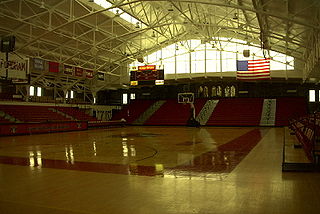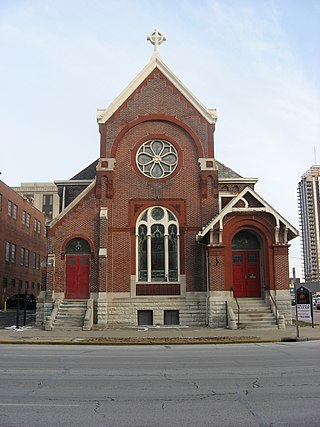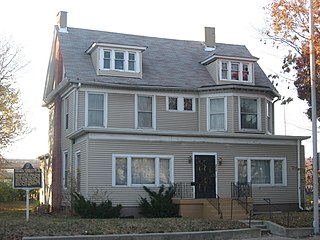
Turners are members of German-American gymnastic clubs called Turnvereine. They promoted German culture, physical culture, and liberal politics. Turners, especially Francis Lieber, 1798–1872, were the leading sponsors of gymnastics as an American sport and the field of academic study.
Physical culture, also known as body culture, is a health and strength training movement that originated during the 19th century in Germany, the UK and the US.

Rose Hill Gymnasium is a 3,200-seat multi-purpose arena on the Rose Hill campus of Fordham University in The Bronx, New York City, New York. The arena, which opened in 1925, is the oldest on-campus venue currently used primarily for an NCAA Division I basketball team and the second-oldest overall. volleyball team of Fordham University also uses the gym. The Rose Hill Gymnasium has a gothic facade in keeping with the rest of Fordham University's buildings. The interior design features two high-tech video boards, bleachers that surround all four sides of the court, and additional elevated seating along the court. ESPN named this gym one of the four “cathedrals” of college basketball. At the time it was built, it was one of the largest on-campus facilities in the country, earning it the nickname "The Prairie." The Rose Hill Gymnasium has been the site of many legendary college and high school basketball games, including the final high school game of Lew Alcindor, later known as Kareem Abdul-Jabbar. During World War II, it was also used as a barracks. New York City Mayor Ed Koch lived in these barracks for a time. As early as 1970, an effort headed by famed Fordham alumnus Vince Lombardi was made to build a new arena. This effort ended with Lombardi's death and the move of head basketball coach "Digger" Phelps to the University of Notre Dame.

Crispus Attucks High School is a public high school of Indianapolis Public Schools in Indianapolis, Indiana, U.S. Its namesake, Crispus Attucks, was an African American patriot killed during the Boston Massacre. The school was built northwest of downtown Indianapolis near Indiana Avenue and opened on September 12, 1927, when it was the only public high school in the city designated specifically for African Americans.

Hinkle Fieldhouse is a basketball arena on the campus of Butler University in Indianapolis, Indiana. Completed in early 1928, it was the largest basketball arena in the United States until 1950. The facility was renamed Hinkle Fieldhouse in 1966 in honor of Butler's longtime coach and athletic director, Paul D. "Tony" Hinkle. It is the sixth-oldest college basketball arena still in use. Added to the National Register of Historic Places in 1983 and designated a U.S. National Historic Landmark in 1987, Hinkle Fieldhouse is sometimes referred to as "Indiana's Basketball Cathedral."

The German-English Academy Building is a school built in Milwaukee, Wisconsin in 1891 for the German-English Academy, which later became the University School of Milwaukee. The building is listed on the National Register of Historic Places and is now owned by the Milwaukee School of Engineering. Since 2012, it has been leased to the company Direct Supply as a technology center. It is beside the Grohmann Museum.
The Bates–Hendricks neighborhood is situated just south and east of the downtown commercial district of Indianapolis, Indiana. The Fountain Square business district is just to the east.

Turner Hall is a historic athletic club facility at 1034 North 4th Street in Milwaukee, Wisconsin. Named using the German "Turnen", meaning gymnastics or physical fitness, it is significant for its association with the American Turners, a German-American athletic, cultural, and political association. The Milwaukee group was founded in 1853 under the title, "Socialist Turnverein"; its leaders included Socialist Congressman Victor Berger. The building is one of the largest and most distinctive surviving buildings associated with the Turner movement, and was designated a National Historic Landmark in 1996. It is now used as a performance and meeting venue.

St. Mary Catholic Church is a parish of the Roman Catholic Church in Indianapolis, Indiana, in the Archdiocese of Indianapolis.

The Athenæum, originally named Das Deutsche Haus, is the most ornate and best-preserved building affiliated with the German American community of Indianapolis. Once used as a German American Turnverein and clubhouse, it currently houses many groups, organizations, and businesses. The Athenæum is located across Massachusetts Avenue from the Old National Centre. It was placed on the National Register of Historic Places on February 21, 1973. On October 31, 2016, it was named the 41st National Historic Landmark in Indiana.

A gym, short for gymnasium, is an indoor venue for exercise and sports. The word is derived from the ancient Greek term "gymnasion". They are commonly found in athletic and fitness centres, and as activity and learning spaces in educational institutions. "Gym" is also the commonly used name for a "fitness centre" or health club, which is often an area for indoor recreation. A "gym" may include or describe adjacent open air areas as well. In Western countries, "gyms" often describe places with indoor or outdoor courts for basketball, hockey, tennis, boxing or wrestling, and with equipment and machines used for physical development training, or to do exercises. In many European countries, Gymnasium also can describe a secondary school that prepares students for higher education at a university, with or without the presence of athletic courts, fields, or equipment.

The Northwest Davenport Turner Society Hall is a historic building located in the old northwest side of Davenport, Iowa, United States. It has been listed on the National Register of Historic Places since 1979. The Northwest Davenport Turner Society Hall is significant for its association with Davenport's German community, which was the city's largest and most influential immigrant group. It also played an important role in the civic and cultural life of the northwest Davenport German community.

The Cottage Home Historic District is a historic district and neighborhood located on the near east side of Indianapolis, Indiana. A small portion of Cottage Home is listed on the National Register of Historic Places while a larger area is listed on the state and local levels. Known for its preponderance of "cottage-style" homes built with strong Victorian influences, Cottage Home has historically been a working class neighborhood. Numerous industrial buildings are also scattered throughout the district, providing a base of economic activity. Today, however, many of these buildings are vacant, providing a special challenge to preservation and urban renewal efforts.

The Bethel A.M.E. Church, known in its early years as Indianapolis Station or the Vermont Street Church, is a historic African Methodist Episcopal Church in Indianapolis, Indiana. Organized in 1836, it is the city's oldest African-American congregation. The three-story church on West Vermont Street dates to 1869 and was added to the National Register in 1991. The surrounding neighborhood, once the heart of downtown Indianapolis's African American community, significantly changed with post-World War II urban development that included new hotels, apartments, office space, museums, and the Indiana University–Purdue University at Indianapolis campus. In 2016 the congregation sold their deteriorating church, which will be used in a future commercial development. The congregation built a new worship center at 6417 Zionsville Road in Pike Township, Marion County, Indiana.

Roberts Park Methodist Episcopal Church, whose present-day name is Roberts Park United Methodist Church, was dedicated on August 27, 1876, making it one of the oldest church remaining in downtown Indianapolis. Diedrich A. Bohlen, a German-born architect who immigrated to Indianapolis in the 1850s, designed this early example of Romanesque Revival architecture. The church is considered one of Bohlen's major works. Constructed of Indiana limestone at Delaware and Vermont Streets, it has a rectangular plan and includes a bell tower on the southwest corner. The church is known for its interior woodwork, especially a pair of black-walnut staircases leading to galleries (balconies) surrounding the interior of three sides of its large sanctuary. The church was added to the National Register of Historic Places on August 19, 1982. It is home to one of several Homeless Jesus statues around the world, this one located behind the church on Alabama Street.

The Indianapolis Athletic Club was a private social "city club" founded in 1920. The Indianapolis Athletic Club building which housed the Club was located at 350 North Meridian Street in Downtown Indianapolis, Indiana. The historic clubhouse was designed by Robert Frost Daggett and built between 1922 and 1924. It is an Italian Renaissance style brick building. The club closed in 2004 and the building was converted to luxury condominiums.

Mount Pisgah Lutheran Church, also known in its early years as the First Lutheran Church and First English Lutheran Church and more recently as The Sanctuary on Penn, is located at 701 North Pennsylvania Street in downtown Indianapolis, Indiana. The historic church was built by the city's first Lutheran congregation, which organized in 1837, and was its third house of worship. The former church, whose present-day name is The Sanctuary on Penn, is operated as a for-profit event venue.

Independent Turnverein, also known as the Hoosier Athletic Club and Marott Building, is a historic Turnverein clubhouse located at Indianapolis, Indiana. It was built in 1907 and consists of a main three-story brick pavilion connected by a two-story section to a second three-story brick pavilion. It has Prairie School and American Craftsman design elements, including a red tile hipped roof. It features paneled and decorated pilasters, a second floor Palladian window, and limestone decorative elements. The building was remodeled in 1946.

Indiana State Federation of Colored Women's Clubs, also known as the Minor House, is a historic National Association of Colored Women's Clubs clubhouse in Indianapolis, Indiana. The two-and-one-half-story "T"-plan building was originally constructed in 1897 as a private dwelling for John and Sarah Minor; however, since 1927 it has served as the headquarters of the Indiana State Federation of Colored Women's Clubs, a nonprofit group of African American women. The Indiana federation was formally organized on April 27, 1904, in Indianapolis and incorporated in 1927. The group's Colonial Revival style frame building sits on a brick foundation and has a gable roof with hipped dormers. It was listed on the National Register of Historic Places in 1987.
Turnverein Building may refer to various clubhouse and gymnasium buildings in the United States constructed for the Turners, including:






















